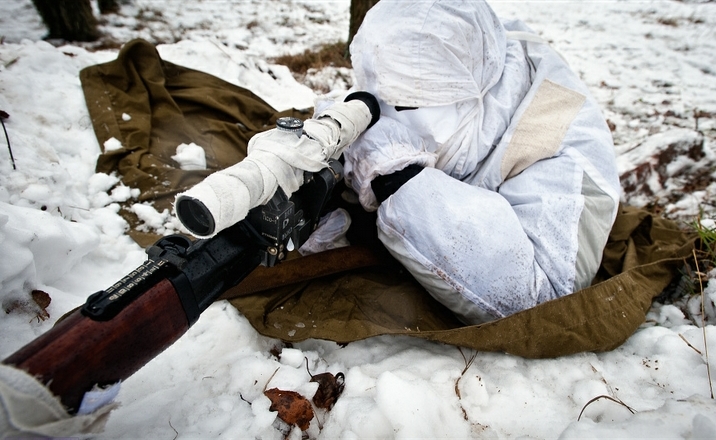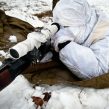
Russia Expands the Role of Army Snipers
Publication: Eurasia Daily Monitor Volume: 9 Issue: 56
By:

In the aftermath of the Arab Spring, the Russian military top brass announced yet another planned innovation for the Armed Forces involving the introduction of sniper units in the “new look” Ground Forces’ brigades. Since the fall of 2011, the defense ministry has intensified its efforts to form command and control, as well as to train and equip specialist sniper units with the aim of staffing these exclusively with contract personnel by 2015. A recent short report on Russian television showcased a sniper school in Krasnodar Territory, displaying simulators and field training. Though the featured interview was conducted with the only conscript attending the course, the trend is toward manning these structures strictly with contract servicemen (Center TV, March 17; Krasnaya Zvezda, March 12).
Pavel Gerasimov justified the renewed level of interest in sniper development in the Russian Armed Forces in an article in Krasnaya Zvezda in terms of their utility in combating terrorism. He further explained that the Ground Forces Main Command has overseen forming sniper companies in all the combined-arms brigades. The command has also formulated a time-phased, multilevel system to psychologically screen and train specialist snipers for operations in subunits and independently. Sniper training centers have been formed under the military district (MD) training facilities and recruits will undergo specialist training then return every three to four years for additional courses. Specialist curricula were developed covering the adjustment of artillery fire, guiding army aircraft and counter-sniper training. The training schools are staffed with instructors who completed a specialist weapons training program at Solnechnogorsk, near Moscow. According to Colonel-General Aleksandr Postnikov, the Commander-in-Chief (CINC) of the Ground Forces, these sniper companies will appear in their final form by 2015, equipped with state-of-the-art weaponry. In order to accomplish a variety of fire missions, several types of rifle are planned for use in the units moving away from heavy reliance upon the Dragunov sniper rifle (SVD) and introducing rifles with laser optics, as well as providing each sniper with optical-surveillance equipment and other assets to determine fire data (Krasnaya Zvezda, March 10; Krasnaya Zvezda, February 29).
During a recent interview, General Postnikov referred to the relatively recent introduction of the sniper companies in the Ground Forces brigades, while setting out the long term goal of achieving a corps of highly trained professional snipers. According to Postnikov, these will be necessary to use in order to resolve “urgent problems” linked to combating terrorism; no other potential use is mentioned in the public comments by the top brass (Krasnaya Zvezda, February 29). “Interim quotas of the provision with arms and military-technical assets, communication facilities, and personal gear and equipment of the sniper subunits of force groupings and units have been introduced for the time being,” Postnikov announced (RIA Novosti, February 21). Clearly, diversifying the type of rifles used in the sniper companies is on hold until these formations are more fully manned and trained by 2015.
In September 2011, Army-General Nikolai Makarov, the Chief of the General Staff, explained that the first sniper companies had been formed in the Southern MD, serving as a test case for their wider introduction. Despite the widening insurgency in the North Caucasus, the defense ministry has refused to make any linkage between these units being formed in the MD and the ongoing security challenges facing the authorities. The Ground Forces Main Command also formulated the conceptual model for the sniper companies, according to which each company will consist of four platoons: placing the sniper companies directly under the brigade commander. The table of organization and equipment (TOE) prescribes 25 soldiers, excluding the platoon leader, in the specialist platoons with armored vehicles in their inventory and 16 soldiers, plus the platoon leader, operating in the rifle platoons; consequently these brigades are actively seeking to enhance their capacity to train such specialists in sufficient numbers. Selection criteria for entry into the sniper companies is apparently rigorous. Each serviceman must have a high level of physical fitness, no visual impairment, along with a minimum of secondary education including mathematics, and demonstrate an ability to quickly calculate accurately using shooting data formulae. Each member of the company is regularly screened by a military psychologist, which can result on rare occasions in a recommendation to the brigade commander to reassign the individual to an alternative unit (Krasnaya Zvezda, March 12, 10). Brigade commanders also note that the process of transferring the manning of these units to 100 percent contract personnel is proceeding slowly, with the debilitating impact, meanwhile, of conscripts leaving the companies twice each year.
Much of the Russian media coverage has stressed that neither the Soviet nor the Russian Armed Forces benefited from possessing such substructures. However, within the new look combined-arms brigades, sniper platoons existed in the brigade structure to support the battalions and were also placed under the brigade commander (Krasnaya Zvezda, March 12, 10). It appears that based on the extent combined-arms brigade structure, the defense ministry opted to use the sniper platoons as providing a basis to form the new sniper companies. Although these are notionally directly subordinate to the brigade commander, it is likely they report and receive orders from staff within the brigade command, as well as work closely with intelligence and reconnaissance units.
In early March 2012, more than 70 officers, sergeants and soldiers graduated from a three month training course in the sniper school in the Eastern MD. The Eastern MD spokesman, Aleksandr Gordeyev, stated that these courses involve sniper tactics, collecting battlefield intelligence, camouflage techniques, military topography and medicine. In a deviation from standard sniper training, the course also experimented with “sniper duels,” tasking a pair of snipers to hit a pair of simulated enemies (Interfax, March 7). Reportedly, tactical training in relation to movement on the battlefield continues to use the sniper pair (sniper and assault rifleman) as the core element, though greater emphasis is being placed on their ability to function autonomously (Krasnaya Zvezda, March 10).
These changes within the Ground Forces’ brigades, unforeseen at the outset of the reform of the Armed Forces in 2008, provide additional evidence of the piecemeal planning approach pursued by the defense ministry leadership. Like other initiatives such as the introduction of Military Police, these measures illustrate the low planning capacity that has become synonymous with the reform. Equally, the new drive to expand the role of army snipers remains largely a paper capability until the manning and equipping plans for the TOE are implemented in the future.




